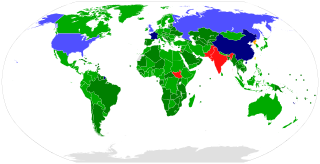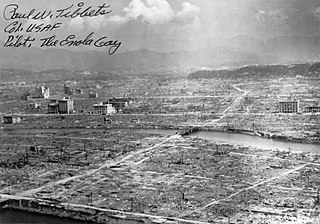Related Research Articles

The Treaty on the Non-Proliferation of Nuclear Weapons, commonly known as the Non-Proliferation Treaty or NPT, is an international treaty whose objective is to prevent the spread of nuclear weapons and weapons technology, to promote cooperation in the peaceful uses of nuclear energy, and to further the goal of achieving nuclear disarmament and general and complete disarmament. Between 1965 and 1968, the treaty was negotiated by the Eighteen Nation Committee on Disarmament, a United Nations-sponsored organization based in Geneva, Switzerland.

Nuclear disarmament is the act of reducing or eliminating nuclear weapons. It can also be the end state of a nuclear-weapons-free world, in which nuclear weapons are completely eliminated. The term denuclearization is also used to describe the process leading to complete nuclear disarmament.
The Hwasong-7, also known as Rodong-1 or Nodong-1, is a single-stage, mobile liquid propellant medium-range ballistic missile developed by North Korea. Developed in the mid-1980s, it is a scaled up adaptation of the Soviet SS-1, more commonly known by its NATO reporting name "Scud". Inventory is estimated to be around 200–300 missiles. US Air Force National Air and Space Intelligence Center estimates that as of June 2017 fewer than 100 launchers were operationally deployed.

The People's Republic of China has developed and possesses weapons of mass destruction, including chemical and nuclear weapons. The first of China's nuclear weapons tests took place in 1964, and its first hydrogen bomb test occurred in 1967. Tests continued until 1996, when China signed the Comprehensive Test Ban Treaty (CTBT). China has acceded to the Biological and Toxin Weapons Convention (BWC) in 1984 and ratified the Chemical Weapons Convention (CWC) in 1997.
The Missile Technology Control Regime (MTCR) is a multilateral export control regime. It is an informal political understanding among 35 member states that seek to limit the proliferation of missiles and missile technology. The regime was formed in 1987 by the G-7 industrialized countries. The MTCR seeks to limit the risks of proliferation of weapons of mass destruction (WMD) by controlling exports of goods and technologies that could make a contribution to delivery systems for such weapons. In this context, the MTCR places particular focus on rockets and unmanned aerial vehicles capable of delivering a payload of at least 500 kg (1,100 lb) to a range of at least 300 km and on equipment, software, and technology for such systems.

In the 1970s and 80s, during the military regime, Brazil had a secret program intended to develop nuclear weapons. The program was dismantled in 1990, five years after the military regime ended, and Brazil is considered free of weapons of mass destruction.

Iran is not known to currently possess weapons of mass destruction (WMD) and has signed treaties repudiating the possession of WMDs including the Biological Weapons Convention, the Chemical Weapons Convention, and the Non-Proliferation Treaty (NPT). Iran has first-hand knowledge of WMD effects—over 100,000 Iranian troops and civilians were victims of chemical weapons during the 1980s Iran–Iraq War.

The nuclear weapons debate refers to the controversies surrounding the threat, use and stockpiling of nuclear weapons. Even before the first nuclear weapons had been developed, scientists involved with the Manhattan Project were divided over the use of the weapon. The only time nuclear weapons have been used in warfare was during the final stages of World War II when United States Army Air Forces B-29 Superfortress bombers dropped atomic bombs on the Japanese cities of Hiroshima and Nagasaki in early August 1945. The role of the bombings in Japan's surrender and the U.S.'s ethical justification for them have been the subject of scholarly and popular debate for decades.

JSC Rosoboronexport is the sole state intermediary agency for Russia's exports/imports of defense-related and dual use products, technologies and services. The Rosoboronexport Federal State Unitary Enterprise (FSUE) was set up in 2000 by a Decree of the President of Russia and is charged with implementation of the policy of the State in the area of military-technical cooperation between Russia and foreign countries. In 2007, the enterprise was re-registered as Rosoboronexport Open joint-stock company (OJSC). In 2011, Rostekhnologii non-profit state corporation acquired 100% of Rosoboronexport OJSC.
Iran's military industry manufactures various types of arms and military equipment. Iran's military industry, under the command of Iran's Ministry of Defence and Armed Forces Logistics, is composed of the following main components:

The Fajr-3 is an Iranian heavy 240 mm intermediate-range multiple-launch artillery rocket (MLRS). The Fajr-3 is a license-built copy, with slight modifications, of a North Korean MLRS called the M-1985. The Fajr-3 was introduced in the 1990s and has since been exported to Hamas and Hezbollah.

The Defense Industries Organization (DIO) is a conglomerate of companies run by the Islamic Republic of Iran whose function is to provide the Armed Forces with the necessary manufacturing capacity and technical abilities. In recent years, the DIO has attempted to become export-oriented, allowing Iran to become an exporter of weapons.

The Iranian Armed Forces comprise the Army (Artesh), the Revolutionary Guard Corps (Sepāh) and the Law Enforcement Force (Police) of the Islamic Republic of Iran.
In the United Kingdom there were direct sales to both sides in the Iran–Iraq War. With an embargo in effect various companies also supplied Iraq and Iran by shipping materials through third-party countries and from those countries to the belligerents. While some of this exporting was legal, permitted or tolerated by parliament, Iraqi clandestine procurement operations were especially active in Britain.
North Korea supported Iran during the Iran–Iraq War for oil and foreign exchange by selling both domestically produced arms to Iran and serving as an intermediary for deniable sales by the Soviet Union, Soviet satellites, and China. Sales began with a delivery of Soviet artillery ammunition in October 1980 after the Iran–Iraq War had begun in September.
The Wisconsin Project on Nuclear Arms Control is a private non-profit, non-partisan organization, which, according to its website, "carries out research and public education designed to stop the spread of nuclear weapons, chemical/biological weapons and long-range missiles. It is a private, non-profit, non-partisan foundation that operates in Washington, D.C. under the auspices of the University of Wisconsin."
This timeline of nuclear weapons development is a chronological catalog of the evolution of nuclear weapons rooting from the development of the science surrounding nuclear fission and nuclear fusion. In addition to the scientific advancements, this timeline also includes several political events relating to the development of nuclear weapons. The availability of intelligence on recent advancements in nuclear weapons of several major countries is limited because of the classification of technical knowledge of nuclear weapons development.
Bruce G. Blair is a nuclear security expert and a research scholar at the Program on Science and Global Security at Princeton University's Woodrow Wilson School of Public and International Affairs. Joining the program in May 2013, he focuses on technical and policy steps on the path toward the verifiable elimination of nuclear weapons, specifically on deep bilateral nuclear arms reductions, multilateral arms negotiations and de-alerting of nuclear arsenals. He is co-founder of Global Zero, an international non-partisan group consisting of 300 world leaders, over 150 student chapters and millions of supporters worldwide dedicated to achieving the elimination of nuclear weapons.
Alfred Hempel (1920–1989) was a German businessman. He attracted international attention because of his trade and smuggling of materials used in nuclear facilities in Pakistan, India, Argentina and several other countries.
References
- ↑ "Wisconsin Project Staff Archived 2012-02-17 at the Wayback Machine ," Wisconsin Project on Nuclear Arms Control.
- ↑ Eduardo Lachica, "Activist Chips Away U.S. Support for Liberal Trade, Archived 2007-06-26 at the Wayback Machine " Asian Wall Street Journal March 17, 1999.
- 1 2 Eleanor Clift, "Monitoring the Nuke-Mart Archived 2010-07-06 at the Wayback Machine ," On Wisconsin, November–December 1990.
- 1 2 Ed Foster-Simeon, "The Case of Missing Heavy Water Archived 2010-07-06 at the Wayback Machine ," Washington Times, June 16, 1988, p. E1.
- 1 2 Ruth Conniff, "Proliferation Tango Archived 2011-07-18 at the Wayback Machine ," The Progressive, April, 1998.
- ↑ Gary Milhollin, "Israel’s Reactor in Full Swing – With Norwegian Heavy Water Archived 2009-05-29 at the Wayback Machine ," Aftenposten, July 6, 1989, p. 5.
- ↑ "Israel’s A-Bombs and Norway’s Heavy Water: The Steps to Revelation Archived 2010-07-06 at the Wayback Machine ," Wisconsin Project on Nuclear Arms Control, April 1990.
- ↑ Gary Milhollin, "Attention, Nuke-Mart Shoppers! Archived 2010-07-06 at the Wayback Machine " Washington Post, July 22, 1990, p. C2.
- 1 2 "Achievements Archived 2012-05-02 at the Wayback Machine ," Wisconsin Project on Nuclear Arms Control.
- ↑ Gary Milhollin and Meg Dennison, "China’s Cynical Calculation Archived 2010-07-06 at the Wayback Machine ," New York Times, April 24, 1995, p. A17.
- ↑ Gary Milhollin, "Exporting an Arms Race Archived 2010-07-06 at the Wayback Machine ," New York Times, February 20, 1996, p. A19.
- ↑ Gary Milhollin, "Rein In Technology Exports Archived 2010-07-06 at the Wayback Machine ," Los Angeles Times, February 26, 1997, p. A11.
- ↑ Gary Milhollin, "Made in America? Archived 2016-03-04 at the Wayback Machine " Washington Post, June 7, 1998, p. C1.
- ↑ Gary Milhollin, "Stop Exporting Nuclear Technology Archived 2010-11-12 at the Wayback Machine ," Los Angeles Times, October 14, 1998, p. B7.
- ↑ Gary Milhollin, "Helping Others Build the Bomb Archived 2010-07-06 at the Wayback Machine ," Washington Post, December 14, 1998, p. A23.
- ↑ House Armed Services Committee Approves Fiscal Year 2005 Defense Authorization Bill, U.S. House of Representatives Committee on Armed Services. May 13, 2004.
- ↑ Testimony of Gary Milhollin Before the House Committee on International Relations Archived 2010-07-06 at the Wayback Machine , March 8, 2006.
- ↑ Steven Weisman, "Lack of ID Data Impedes U.N. Sanctions Against Iran," New York Times, September 17, 2007.
- ↑ Valerie Lincy, "U.S. Failure to Follow Through on Iran Sanctions is Baffling," World Politics Review, May 31, 2007.
- ↑ "Chinese Exports to Iran Archived 2010-07-06 at the Wayback Machine ," Wisconsin Project on Nuclear Arms Control, April 7, 2009.
- ↑ "Press Release: Indictment of a Chinese citizen and his company," New York County District Attorney's Office, News Release, April 7, 2009.
- ↑ "Indictment of Li Fang Wei and LIMMT Economic and Trade Company," Supreme Court of the State of New York, County of New York, April 7, 2009.
- ↑ "Gary Milhollin, North Korea Shows Dangers of Half-Deal With Iran," Bloomberg View, February 24, 2013.
- ↑ "Gary Milhollin, How U.S. Can Break Up Iran’s Long Nuclear Game," Bloomberg View, May 13, 2013.
- ↑ "About Us," Iran Watch.
- ↑ The Risk Report Archived 2010-11-22 at the Wayback Machine , The Wisconsin Project on Nuclear Arms Control.
- ↑ "About Us," Iraq Watch.
- ↑ "Profile of Gary Milhollin," Faculty and Staff, University of Wisconsin Law School.
- ↑ "Wisconsin Project Publications: Articles and Commentary". Archived from the original on 2010-07-06. Retrieved 2010-11-23.
- ↑ Wisconsin Project Publications: Testimony, Reports, and Speeches.
- ↑ Wisconsin Project Publications Archived 2010-10-11 at the Wayback Machine .
- ↑ Law School Faculty Archived 2010-06-15 at the Wayback Machine , Prospective Students Viewbook, University of Wisconsin Law School.